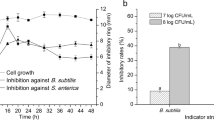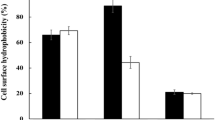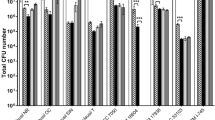Abstract
This work aimed to investigate the effect of EPS (extracellular polysaccharide) of Weissella cibaria as a prebiotic to promote the growth and antibacterial properties of Lactobacillus rhamnosus. The morphological, growth behavior, and antibacterial properties of L. rhamnosus were determined in MRSB (de Man Rogosa Sharpe broth) supplemented with different concentrations of EPS (0.1–2%). The results revealed that the incorporation of the EPS (2%) in MRSA improved the bacterial growth in terms of colony-forming unit (CFU, 0.7 × 105 CFU/mL) compared to L. rhamnosus grown in bare MRSA. The SEM observation revealed that EPS incorporation in the MRSB culture media does not affect the morphological properties of L. rhamnosus. Moreover, it was confirmed that the extract of probiotics cultured in MRSA supplemented with EPS (2%) was exhibited strong antibacterial and antibiofilm activity against targeted pathogens. This L. rhamnosus extract was found to be biocompatible evidanced by erythrocyte hemolysis assay. These results confirmed that EPS regulates the growth of probiotics, resists pathogen infection, and biocompatibility.





Similar content being viewed by others
Data Availability
The data generated and analyzed during the current study are available from the corresponding author on reasonable request.
References
Bermudez-Brito, M., Plaza-Díaz, J., Muñoz-Quezada, S., Gómez-Llorente, C., & Gil, A. (2012). Probiotic mechanisms of action. Annals of Nutrition and Metabolism, 61, 160–174.
Brugger, S. D., Baumberger, C., Jost, M., Jenni, W., Brugger, U., & Mühlemann, K. (2012). Automated Counting of Bacterial Colony Forming Units on Agar Plates. PLoS ONE, 7, e33695.
Chin-Lee, B., Curry, W. J., Fetterman, J., Graybill, M. A., & Karpa, K. (2014). Patient experience and use of probiotics in community-based health care settings. Patient Preference and Adherence, 8, 1513–1520.
Dlamini, A. M., Peiris, P. S., Bavor, J. H., & Kailasapathy, K. (2009). Rheological characteristics of an exopolysaccharide produced by a strain of Klebsiella oxytoca. Journal of Bioscience and Bioengineering, 107, 272–274.
Feng, K., Zhai, M.-Y., Zhang, Y., Linhardt, R. J., Zong, M.-H., Li, L., & Wu, H. (2018). Improved viability and thermal stability of the probiotics encapsulated in a novel electrospun fiber mat. Journal of Agricultural and Food Chemistry, 66, 10890–10897.
Gibson, G. R., & Roberfroid, M. B. (1995). Dietary modulation of the human colonic microbiota: Introducing the concept of prebiotics. The Journal of Nutrition, 125, 1401–1412.
Hlaing, M. M., Wood, B. R., McNaughton, D., Ying, D., Dumsday, G., & Augustin, M. A. (2017). Effect of drying methods on protein and DNA conformation changes in Lactobacillus rhamnosus GG cells by Fourier transform infrared spectroscopy. Journal of Agricultural and Food Chemistry, 65, 1724–1731.
İspirli, H., Demirbaş, F., & Dertli, E. (2018). Glucan type exopolysaccharide (EPS) shows prebiotic effect and reduces syneresis in chocolate pudding. Journal of Food Science and Technology, 55, 3821–3826.
Jahangirian, H., Halim, M., Ismail, M. H. S., RafieeMoghaddam, R., AfsahHejri, L., Abdollahi, Y., Rezayi, M., & Vafaei, N. (2013). Well diffusion method for evaluation of antibacterial activity of copper phenyl fatty hydroxamate synthesized from canola and palm kernel oils. Digest Journal of Nanomaterials and Biostructures, 8, 1263–1270.
Koch, A. L. (1996). WHAT SIZE SHOULD A BACTERIUM BE? A Question of Scale. Annual Review of Microbiology, 50, 317–348.
Li, W., Xia, X., Tang, W., Ji, J., Rui, X., Chen, X., Jiang, M., Zhou, J., Zhang, Q., & Dong, M. (2015). Structural characterization and anticancer activity of cell-bound exopolysaccharide from Lactobacillus helveticus MB2-1. Journal of Agricultural and Food Chemistry, 63, 3454–3463.
Markowiak, P., & Śliżewska, K. (2017). Effects of probiotics, prebiotics, and synbiotics on human health. Nutrients, 9, 1021.
Nagpal, R., & Kaur, A. (2011). Synbiotic Effect of Various Prebiotics on In Vitro Activities of Probiotic Lactobacilli. Ecology of Food and Nutrition, 50, 63–68.
Naumann, D., Helm, D., & Schultz, C. (1994). Characterization and identification of micro-organisms by FT-IR spectroscopy and FT-IR microscopy. In F. G. Priest, A. Ramos-Cormenzana, & B. J. Tindall (Eds.), Bacterial diversity and systematics (pp. 67–85). Springer US.
Nguyen, P.-T., Nguyen, T.-T., Bui, D.-C., Hong, P.-T., Hoang, Q.-K., & Nguyen, H.-T. (2020). Exopolysaccharide production by lactic acid bacteria: The manipulation of environmental stresses for industrial applications. AIMS Microbiol, 6, 451–469.
Oust, A., Møretrø, T., Kirschner, C., Narvhus, J. A., & Kohler, A. (2004). FT-IR spectroscopy for identification of closely related lactobacilli. Journal of Microbiological Methods, 59, 149–162.
Park, S., Saravanakumar, K., Sathiyaseelan, A., Park, S., Hu, X., & Wang, M.-H. (2022). Cellular antioxidant properties of nontoxic exopolysaccharide extracted from Lactobacillales (Weissella cibaria) isolated from Korean kimchi. LWT, 154, 112727.
Rajendran, I., Dhandapani, H., Anantanarayanan, R., & Rajaram, R. (2015). Apigenin mediated gold nanoparticle synthesis and their anti-cancer effect on human epidermoid carcinoma (A431) cells. RSC Advances, 5, 51055–51066.
Ribeiro, S. C., Stanton, C., Yang, B., Ross, R. P., & Silva, C. C. G. (2018). Conjugated linoleic acid production and probiotic assessment of Lactobacillus plantarum isolated from Pico cheese. LWT, 90, 403–411.
Saravanakumar, K., Park, S., Sathiyaseelan, A., Mariadoss, A. V. A., Park, S., Kim, S.-J., & Wang, M.-H. (2021). Isolation of polysaccharides from Trichoderma harzianum with antioxidant, anticancer, and enzyme inhibition properties. Antioxidants, 10, 1372.
Sharma, S., & Kanwar, S. S. (2018). Effect of prebiotics on growth behavior of Lactobacillus plantarum and their impact on adherence of strict anaerobic pathogens to intestinal cell lines. Journal of Food Safety, 38, e12384.
Vuotto, C., Longo, F., & Donelli, G. (2014). Probiotics to counteract biofilm-associated infections: Promising and conflicting data. International Journal of Oral Science, 6, 189–194.
Wang, X., Huang, M., Yang, F., Sun, H., Zhou, X., Guo, Y., Wang, X., & Zhang, M. (2015). Rapeseed polysaccharides as prebiotics on growth and acidifying activity of probiotics in vitro. Carbohydrate Polymers, 125, 232–240.
Welman, A. D., & Maddox, I. S. (2003). Exopolysaccharides from lactic acid bacteria: Perspectives and challenges. Trends in Biotechnology, 21, 269–274.
Wu, S., Xu, C., Zhu, Y., Zheng, L., Zhang, L., Hu, Y., Yu, B., Wang, Y., & Xu, F.-J. (2021). Biofilm-Sensitive Photodynamic Nanoparticles for Enhanced Penetration and Antibacterial Efficiency. Advanced Functional Materials, 31, 2103591.
Yanti, Rukayadi, Y., Kim, K.-H., & Hwang, J.-K. (2008) In vitro anti-biofilm activity of macelignan isolated from Myristica fragrans Houtt. against oral primary colonizer bacteria. Phytotherapy Research, 22, 308-312.
Zhu, Y., Liu, L., Sun, Z., Ji, Y., Wang, D., Mei, L., Shen, P., Li, Z., Tang, S., Zhang, H., Zhou, Q., & Deng, J. (2021). Fucoidan as a marine-origin prebiotic modulates the growth and antibacterial ability of Lactobacillus rhamnosus. International Journal of Biological Macromolecules, 180, 599–607.
Funding
This work was supported by Brain Pool Program through the National Research Foundation of Korea (NRF) funded by the Ministry of Science, ICT and Future Planning (2017H1D3A1A01052610), National Research Foundation of Korea (2019R1A1055452).
Author information
Authors and Affiliations
Contributions
Soyoung Parka: formal analysis, investigation, methodology, writing—original draft. Kandasamy Saravanakumar: conceptualization, data curation, formal analysis, investigation, methodology, visualization, writing—original draft, writing—review and editing. Anbazhagan Sathiyaseelan: formal analysis, data curation. Ki-seok Han: formal analysis, investigation. Jooeun Lee: investigation, methodology. Myeong-Hyeon Wang: project administration, resources, supervision, validation, writing—review and editing.
Corresponding author
Ethics declarations
Ethics Approval
This article does not contain any studies with animals or human participants.
Consent to Participate
The authors agreed to participate in this work.
Consent for Publication
The authors agreed to publish this work.
Conflict of Interest
The authors declare no competing interests.
Additional information
Publisher's Note
Springer Nature remains neutral with regard to jurisdictional claims in published maps and institutional affiliations.
Rights and permissions
Springer Nature or its licensor holds exclusive rights to this article under a publishing agreement with the author(s) or other rightsholder(s); author self-archiving of the accepted manuscript version of this article is solely governed by the terms of such publishing agreement and applicable law.
About this article
Cite this article
Park, S., Saravanakumar, K., Sathiyaseelan, A. et al. Polysaccharides of Weissella cibaria Act as a Prebiotic to Enhance the Probiotic Potential of Lactobacillus rhamnosus. Appl Biochem Biotechnol 195, 3928–3940 (2023). https://doi.org/10.1007/s12010-022-04104-2
Accepted:
Published:
Issue Date:
DOI: https://doi.org/10.1007/s12010-022-04104-2




